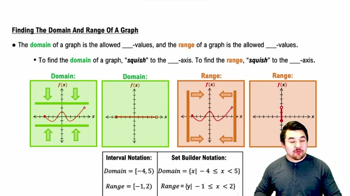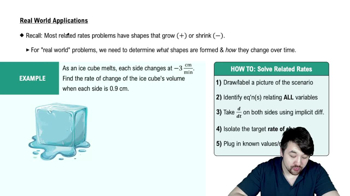Table of contents
- 0. Functions7h 52m
- Introduction to Functions16m
- Piecewise Functions10m
- Properties of Functions9m
- Common Functions1h 8m
- Transformations5m
- Combining Functions27m
- Exponent rules32m
- Exponential Functions28m
- Logarithmic Functions24m
- Properties of Logarithms34m
- Exponential & Logarithmic Equations35m
- Introduction to Trigonometric Functions38m
- Graphs of Trigonometric Functions44m
- Trigonometric Identities47m
- Inverse Trigonometric Functions48m
- 1. Limits and Continuity2h 2m
- 2. Intro to Derivatives1h 33m
- 3. Techniques of Differentiation3h 18m
- 4. Applications of Derivatives2h 38m
- 5. Graphical Applications of Derivatives6h 2m
- 6. Derivatives of Inverse, Exponential, & Logarithmic Functions2h 37m
- 7. Antiderivatives & Indefinite Integrals1h 26m
- 8. Definite Integrals4h 44m
- 9. Graphical Applications of Integrals2h 27m
- 10. Physics Applications of Integrals 2h 22m
4. Applications of Derivatives
Related Rates
Problem 30c
Textbook Question
Consider the following cost functions.
c. Interpret the values obtained in part (b).
C(x) = 500+0.02x, 0≤x≤2000, a=1000
 Verified step by step guidance
Verified step by step guidance1
First, identify the cost function given: C(x) = 500 + 0.02x, where x represents the number of units produced.
Next, understand the range of x, which is 0 ≤ x ≤ 2000. This means the function is valid for production levels between 0 and 2000 units.
In part (b), you would typically be asked to evaluate the cost function at a specific value of x, which in this case is a = 1000. Substitute x = 1000 into the cost function to find C(1000).
Calculate C(1000) using the formula: C(1000) = 500 + 0.02 * 1000. This will give you the total cost when 1000 units are produced.
Interpret the result obtained from C(1000). The value represents the total cost of producing 1000 units, which includes a fixed cost of 500 and a variable cost that depends on the number of units produced.
 Verified video answer for a similar problem:
Verified video answer for a similar problem:This video solution was recommended by our tutors as helpful for the problem above
Video duration:
3mPlay a video:
Was this helpful?
Key Concepts
Here are the essential concepts you must grasp in order to answer the question correctly.
Cost Function
A cost function represents the total cost incurred by a business in producing a certain quantity of goods, denoted as C(x). In this case, C(x) = 500 + 0.02x indicates that there is a fixed cost of 500 and a variable cost of 0.02 per unit produced. Understanding this function is crucial for analyzing how costs change with production levels.
Recommended video:

Properties of Functions
Interpretation of Values
Interpreting values from a cost function involves understanding what the numerical outputs signify in a real-world context. For instance, in part (b), if a specific value of x is substituted into C(x), the resulting cost can be analyzed to determine the financial implications of producing that quantity, including profitability and cost management.
Recommended video:

Average Value of a Function
Domain of the Function
The domain of a function specifies the set of input values for which the function is defined. In this case, the domain is 0 ≤ x ≤ 2000, meaning the cost function is only applicable for production levels between 0 and 2000 units. Recognizing the domain is essential for ensuring that any analysis or interpretation of the cost function remains relevant and valid within the specified limits.
Recommended video:

Finding the Domain and Range of a Graph
Related Videos
Related Practice






